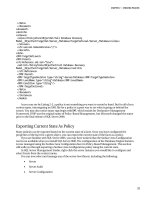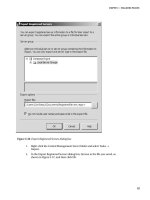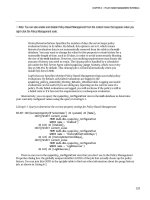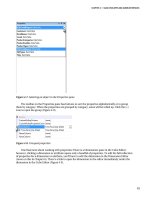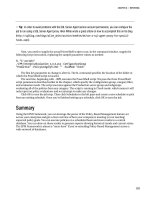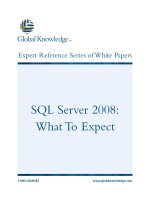Tài liệu Pro SQL Server 2008 Policy-Based Management- P1 doc
Bạn đang xem bản rút gọn của tài liệu. Xem và tải ngay bản đầy đủ của tài liệu tại đây (3.77 MB, 50 trang )
BOOKS FOR PROFESSIONALS BY PROFESSIONALS ®
Pro Server 2008
Policy-Based Management
Dear Reader,
Ken Simmons, Author of
Pro SQL Server 2008
Mirroring
Pro SQL Server 2008
Administration
Colin Stasiuk
Enforcing standards across your organization has always been a difficult task
when it comes to SQL Server. Yet the growing compliance requirements for today’s
organizations make it more important than ever to ensure that your servers are
properly configured. Policy-Based Management could be your salvation. It is a new
feature in SQL Server 2008 enabling you to manage large groups of servers with
consistency, in compliance with company rules and government regulation.
Policy-Based Management is so important that we wrote this book to provide
a central source of deep information to help you implement the feature in your
environment. We cover practical scenarios and give guidance to help you with your
compliance needs. You’ll learn to:
• Maintain a consistent, predictable environment throughout your organization
• Create and evaluate policies to ensure that consistency
• Configure and receive alerts for policy violations
• View the state of your policies through reports and online queries
• Implement policies to help meet compliance regulations
We aim to provide you with the knowledge to make the right decisions when
deploying policies in your environment, as well to provide a quick reference guide
to have at your fingertips on a daily basis. We know that maintaining a stable and
consistent SQL Server environment can be overwhelming at times; however, having the proper configurations in place, and ensuring those configurations remain
consistent by using Policy-Based Management will give you confidence and peace
of mind from knowing that your environment is the way it should be.
Ken Simmons, Colin Stasiuk, Jorge Segarra
Companion
eBook
Available
Pro SQL Server 2008 Policy-Based Management
FPO
THE EXPERT’S VOICE ® IN SQL SERVER
THE APRESS ROADMAP
Beginning
SQL Server 2008
Administration
DBA Survivor:
Become A Rock Star DBA
Policy-Based
Management
Easily manage large server farms by
automating consistent rules and policies
Jorge Segarra
Companion eBook
Pro
SQL Server 2008
Pro
SQL Server 2008
Administration
www.apress.com
Shelve in:
Databases / SQL Server
User level:
Intermediate–Advanced
Please purchase PDF Split-Merge on www.verypdf.com to remove this watermark.
SQL Server 2008
Query Performance Tuning
Simmons
Stasiuk
Segarra
SOURCE CODE ONLINE
Pro
SQL Server 2008
Policy-Based Management
Ken Simmons, Colin Stasiuk, and Jorge Segarra
Please purchase PDF Split-Merge on www.verypdf.com to remove this watermark.
Pro SQL Server 2008
Policy-Based
Management
Ken Simmons
Colin Stasiuk
Jorge Segarra
Please purchase PDF Split-Merge on www.verypdf.com to remove this watermark.
PRO SQL SERVER 2008 POLICY-BASED MANAGEMENT
Copyright © 2010 by Ken Simmons, Colin Stasiuk, Jorge Segarra
All rights reserved. No part of this work may be reproduced or transmitted in any form or by any
means, electronic or mechanical, including photocopying, recording, or by any information storage or
retrieval system, without the prior written permission of the copyright owner and the publisher.
ISBN-13 (pbk): 978-1-4302-2910-0
ISBN-13 (electronic): 978-1-4302-2911-7
Printed and bound in the United States of America 9 8 7 6 5 4 3 2 1
Trademarked names may appear in this book. Rather than use a trademark symbol with every
occurrence of a trademarked name, we use the names only in an editorial fashion and to the benefit of
the trademark owner, with no intention of infringement of the trademark.
President and Publisher: Paul Manning
Lead Editor: Jonathan Gennick
Technical Reviewer: Thomas LaRock
Editorial Board: Clay Andres, Steve Anglin, Mark Beckner, Ewan Buckingham, Gary Cornell,
Jonathan Gennick, Jonathan Hassell, Michelle Lowman, Matthew Moodie, Duncan Parkes,
Jeffrey Pepper, Frank Pohlmann, Douglas Pundick, Ben Renow-Clarke, Dominic Shakeshaft,
Matt Wade, Tom Welsh
Coordinating Editor: Kelly Moritz
Copy Editor: Marilyn Smith
Compositor: Bytheway Publishing Services
Indexer: John Collin
Artist: April Milne
Cover Designer: Anna Ishchenko
Distributed to the book trade worldwide by Springer-Verlag New York, Inc., 233 Spring Street, 6th
Floor, New York, NY 10013. Phone 1-800-SPRINGER, fax 201-348-4505, e-mail , or visit www.springeronline.com.
For information on translations, please e-mail , or visit www.apress.com.
Apress and friends of ED books may be purchased in bulk for academic, corporate, or promotional
use. eBook versions and licenses are also available for most titles. For more information, reference our
Special Bulk Sales–eBook Licensing web page at www.apress.com/info/bulksales.
The information in this book is distributed on an “as is” basis, without warranty. Although every
precaution has been taken in the preparation of this work, neither the author(s) nor Apress shall have
any liability to any person or entity with respect to any loss or damage caused or alleged to be caused
directly or indirectly by the information contained in this work.
The source code for this book is available to readers at www.apress.com. You will need to answer
questions pertaining to this book in order to successfully download the code.
Please purchase PDF Split-Merge on www.verypdf.com to remove this watermark.
To my wife Susan and son Nathan.
– Ken Simmons
For Robbie and Lana, who always put a smile on my face, and for Heather, whose policies always keep me in
check.
– Colin Stasiuk
I’d like to dedicate this book to my wife, Jessica. Without your love, understanding, and support, I wouldn’t
have been able to do this. I love you always and forever.
– Jorge Segarra
Please purchase PDF Split-Merge on www.verypdf.com to remove this watermark.
Contents at a Glance
Contents at a Glance.............................................................................................. iv
Contents.................................................................................................................. v
About the Authors................................................................................................. xii
About the Technical Reviewers ........................................................................... xiii
Acknowledgments ............................................................................................... xiv
Introduction .......................................................................................................... xv
Chapter 1: Introduction to Policy-Based Management...........................................1
Chapter 2: Creating Policies .................................................................................13
Chapter 3: Evaluating Policies ..............................................................................49
Chapter 4: Policy-Based Management Using PowerShell.....................................89
Chapter 5: Receiving Alerts for Policy Violations ...............................................109
Chapter 6: Policy-Based Management Internals ................................................131
Chapter 7: Practical Uses of Policy-Based Management....................................149
Chapter 8: Reporting...........................................................................................169
Chapter 9: Enforcing Compliance .......................................................................185
Chapter 10: Where to Go from Here ....................................................................207
Appendix: Microsoft SQL Server Best Practice Policies .....................................215
Index ...................................................................................................................235
iv
Please purchase PDF Split-Merge on www.verypdf.com to remove this watermark.
CONTENTS
Contents
Contents at a Glance .............................................................................................. iv
Contents.................................................................................................................. v
About the Authors................................................................................................. xii
About the Technical Reviewers ........................................................................... xiii
Acknowledgments ............................................................................................... xiv
Introduction .......................................................................................................... xv
Chapter 1: Introduction to Policy-Based Management...........................................1
What Is Policy-Based Management? .................................................................................1
Why Use Policy-Based Management? ...............................................................................1
Policy-Based Management Requirements.........................................................................2
Policy-Based Management Components...........................................................................3
Targets ..................................................................................................................................................... 3
Facets ....................................................................................................................................................... 4
Conditions................................................................................................................................................. 5
Policies ..................................................................................................................................................... 6
Policy Behavior ..................................................................................................................7
Evaluation Modes ..................................................................................................................................... 7
Server Restrictions ................................................................................................................................... 8
Policy Management ...........................................................................................................9
Categories ................................................................................................................................................ 9
Central Management Servers................................................................................................................... 9
Enterprise Policy Management Framework ........................................................................................... 10
Please purchase PDF Split-Merge on www.verypdf.com to remove this watermark.
v
CONTENTS
Alerts ...................................................................................................................................................... 11
Summary .........................................................................................................................11
Chapter 2: Creating Policies .................................................................................13
Manually Creating Policies ..............................................................................................13
Creating a Condition ............................................................................................................................... 13
Creating a Policy..................................................................................................................................... 16
Viewing Dependent Policies ................................................................................................................... 21
Importing Policies ............................................................................................................24
Exporting Policies ............................................................................................................27
Exporting Existing Policies ..................................................................................................................... 28
Exporting Current State As Policy........................................................................................................... 33
Creating Policies with T-SQL ...........................................................................................35
Managing Policy Categories ............................................................................................37
Creating Policy Categories...................................................................................................................... 37
Subscribing to Categories ...................................................................................................................... 39
Creating Advanced Conditions.........................................................................................40
Defining Conditions for System Databases......................................................................44
Summary .........................................................................................................................47
Chapter 3: Evaluating Policies ..............................................................................49
Evaluation Modes ............................................................................................................49
Evaluation on Demand.....................................................................................................50
Evaluating a Single Policy on Demand ................................................................................................... 50
Evaluating Multiple Policies on Demand ................................................................................................ 55
Evaluating Policies Against a Different Instance .................................................................................... 57
Evaluation on Schedule ...................................................................................................60
Creating a Schedule ............................................................................................................................... 61
Adding Policies to an Existing Schedule................................................................................................. 66
vi
Please purchase PDF Split-Merge on www.verypdf.com to remove this watermark.
CONTENTS
Evaluation on Change: Log Only ......................................................................................67
Evaluation on Change: Prevent........................................................................................74
Using a Central Management Server ...............................................................................76
Creating a Central Management Server ................................................................................................. 77
Creating a Central Management Server Group....................................................................................... 78
Adding Servers to Central Management Server Groups ......................................................................... 80
Registering a Server to a Group ........................................................................................................ 80
Importing Registered Servers and Groups......................................................................................... 81
Evaluating Policies against a Central Management Server Group.......................................................... 84
Summary .........................................................................................................................87
Chapter 4: Policy-Based Management Using PowerShell.....................................89
Creating a Basic PowerShell Script .................................................................................89
Using T-SQL............................................................................................................................................ 89
Using SQL Server Management Objects................................................................................................. 91
Interrogating for Members and Properties ............................................................................................. 93
Running a Policy Against a SQL Server Instance.............................................................95
Invoking a Policy from a File .................................................................................................................. 95
Getting Detailed Results ......................................................................................................................... 96
Invoking a Policy Defined on the Server................................................................................................. 97
Running Multiple Policies Against a SQL Server Instance ...............................................98
Invoking Multiple Policies from the Cmdlet ............................................................................................ 98
Invoking a Category of Policies from the File System ............................................................................ 99
Invoking a Category of Policies from an Instance ................................................................................ 100
Querying and Storing Policy Execution Results .............................................................101
Creating a Staging Table ...................................................................................................................... 102
Loading Policy Evaluation History......................................................................................................... 102
Querying the History ............................................................................................................................. 103
Evaluating Against a Central Management Server ........................................................105
Please purchase PDF Split-Merge on www.verypdf.com to remove this watermark.
vii
CONTENTS
Summary .......................................................................................................................108
Chapter 5: Receiving Alerts for Policy Violations ...............................................109
Configuring Database Mail ............................................................................................109
Setting Up Database Mail ..................................................................................................................... 109
Testing Database Mail .......................................................................................................................... 111
Cleaning Up Database Mail History ...................................................................................................... 113
Creating SQL Server Agent Operators............................................................................116
Enabling SQL Server Agent Notifications.......................................................................118
Creating Alerts ...............................................................................................................120
Troubleshooting Policies................................................................................................126
Viewing Policy History .......................................................................................................................... 126
Viewing History Based on Policies........................................................................................................ 126
Viewing History Based on Objects ........................................................................................................ 127
General Troubleshooting ...................................................................................................................... 129
Summary .......................................................................................................................130
Chapter 6: Policy-Based Management Internals ................................................131
Policy-Based Management Properties...........................................................................131
Policy-Based Management Architecture .......................................................................134
On Demand........................................................................................................................................... 134
On Change: Prevent .............................................................................................................................. 135
On Change: Log Only ............................................................................................................................ 135
On Schedule ......................................................................................................................................... 135
Policy-Based Management Security Issues...................................................................136
Policy-Based Management Tables and Views ...............................................................137
Tables ................................................................................................................................................... 137
Contents of System Policy Tables ................................................................................................... 138
Checking for New Tables................................................................................................................. 141
Views ............................................................................................................................................... 141
viii
Please purchase PDF Split-Merge on www.verypdf.com to remove this watermark.
CONTENTS
syspolicy_conditions ....................................................................................................................... 141
syspolicy_configuration................................................................................................................... 142
syspolicy_object_sets ..................................................................................................................... 142
syspolicy_policies ........................................................................................................................... 142
syspolicy_policy_categories ........................................................................................................... 143
syspolicy_policy_category_subscriptions....................................................................................... 143
syspolicy_policy_execution_history................................................................................................ 143
syspolicy_policy_execution_history_details ................................................................................... 144
syspolicy_system_health_state ...................................................................................................... 144
syspolicy_target_set_levels............................................................................................................ 144
syspolicy_target_sets ..................................................................................................................... 144
Combining Views ............................................................................................................................. 145
Checking for New Views.................................................................................................................. 146
Stored Procedures .........................................................................................................146
Summary .......................................................................................................................148
Chapter 7: Practical Uses of Policy-Based Management....................................149
A DBA Checklist .............................................................................................................149
Custom Policies .............................................................................................................150
Database Free Space............................................................................................................................ 150
Successful Transaction Log Backups................................................................................................... 153
SQL Server Agent Is Running................................................................................................................ 158
All SQL Server Agent Jobs Have Notification on Failure....................................................................... 160
Data Purity Flag Enabled ...................................................................................................................... 163
Best Practices Policies ..................................................................................................166
Summary .......................................................................................................................168
Please purchase PDF Split-Merge on www.verypdf.com to remove this watermark.
ix
CONTENTS
Chapter 8: Reporting...........................................................................................169
EPM Framework Prerequisites ......................................................................................169
Setting Up the EPM Framework.....................................................................................170
The Setup Script ................................................................................................................................... 170
The PowerShell Script .......................................................................................................................... 171
Reporting Services Reports .................................................................................................................. 175
Viewing EPM Framework Reports .................................................................................179
Automating the EPM Framework...................................................................................182
Summary .......................................................................................................................183
Chapter 9: Enforcing Compliance .......................................................................185
Compliance Overview ....................................................................................................185
Compliance Regulations ................................................................................................186
Gramm-Leach-Bliley Act ...................................................................................................................... 186
The Sarbanes-Oxley Act ....................................................................................................................... 187
Health Insurance Portability and Accountability Act............................................................................. 187
Payment Card Industry Data Security Standard ................................................................................... 187
Server Configuration......................................................................................................188
Service Account.................................................................................................................................... 189
Log Retention ....................................................................................................................................... 191
Surface Area Configuration .................................................................................................................. 194
Security..........................................................................................................................195
Administrative Accounts....................................................................................................................... 196
Removing the Builtin\Administrators Login ..................................................................................... 197
Disabling the sa Login ..................................................................................................................... 197
Best Practice Security Policies............................................................................................................. 198
Encryption......................................................................................................................199
Transparent Data Encryption ................................................................................................................ 199
Extensible Key Management ................................................................................................................ 201
x
Please purchase PDF Split-Merge on www.verypdf.com to remove this watermark.
CONTENTS
Best Practice Encryption Policies ......................................................................................................... 202
Auditing .........................................................................................................................202
SQL Server Audit................................................................................................................................... 203
Login Auditing....................................................................................................................................... 203
Default Trace ........................................................................................................................................ 204
Best Practice Audit Policy..................................................................................................................... 206
Summary .......................................................................................................................206
Chapter 10: Where to Go from Here ....................................................................207
Upcoming Releases .......................................................................................................207
SQL Server Web Sites ....................................................................................................207
Blogs..............................................................................................................................208
White Papers..................................................................................................................208
Podcasts ........................................................................................................................209
Free Training Events......................................................................................................209
Social Networking..........................................................................................................210
Microsoft Support Options .............................................................................................211
SQL Server Books Online...................................................................................................................... 211
Webcasts .............................................................................................................................................. 211
SQL Server Troubleshooting and Support Resources........................................................................... 212
Microsoft Technical Communities ........................................................................................................ 212
Paid Support ......................................................................................................................................... 212
Summary .......................................................................................................................213
Appendix: Microsoft SQL Server Best Practice Policies .....................................215
Best Practice Policy Descriptions ..................................................................................215
Best Practice Policy Conditions and Facets...................................................................230
Index ...................................................................................................................235
Please purchase PDF Split-Merge on www.verypdf.com to remove this watermark.
xi
About the Authors
Ken Simmons is a database administrator, developer, and Microsoft SQL
Server MVP. His other books on SQL Server include SQL Server 2008
Administration (Apress, 2009) and Pro SQL Server 2008 Mirroring (Apress,
2009). He has been working in the IT industry since 2000, and currently
holds certifications for MCP, MCAD, MCSD, MCDBA, and MCTS for SQL
Server 2005.
Ken is active in the online community, and often participates in the SQL
Server forums on MSDN and SQLServerCentral.com. He enjoys sharing tips
by writing articles for and http://
MSSQLTips.com. When he is not working, Ken enjoys traveling with his wife
Susan and son Nathan, and he can often be found on a cruise ship, at a Disney resort, or at the beach in
his hometown of Pensacola, Florida.
Colin Stasiuk is a database administrator and owner of Benchmark IT Consulting,
based in Edmonton, Alberta, Canada. He has worked with SQL Server since 1996,
and currently holds certifications for MCP, MCTS, and MCITP for Database
Administration and Development. Colin is also the president of EDMPASS, the
Edmonton-based chapter of the Professional Association for SQL Server (PASS), and
his blog is syndicated at http://SQLServer
Pedia.com.
Colin (like any good Canadian boy) is an avid hockey fan, and enjoys spending
quality time with his wife Heather, son Robbie, and daughter Lana.
Jorge Segarra is a database and system administrator for University Community
Hospital in Tampa, Florida. He has been administering SQL Server for more than five
years, and holds certifications for MCP and MCTS.
Jorge is very active in the online community and can be found on Twitter under the
handle SQLChicken and at his blog . He is also a founding
member (or hypervisor) for the PASS Virtualization Virtual Chapter and a general
volunteer for PASS. On the local level, he is a member of the Tampa SQL Server User
Group as well as the Tampa Bay SQL Server Business Intelligence User Group. Jorge
also enjoys traveling to various local user groups and events to present on all things
SQL Server. When not being a total geek, Jorge enjoys spending time at home with his
wife Jessica.
xii
Please purchase PDF Split-Merge on www.verypdf.com to remove this watermark.
ABOUT THE TECHNICAL REVIEWERS
About the Technical Reviewers
Thomas LaRock is a seasoned IT professional with more than a decade of
technical and management experience. Currently serving as a database
administration manager with ING Investment Management, Thomas has
progressed through several roles at ING, including programmer, analyst, and
database administrator. Prior to ING, he worked with several software and
consulting companies, at customer sites in the United States and abroad. Thomas
holds an MS degree in Mathematics from Washington State University. He is a
member of the Usability Professional’s Association and Quest’s Association of
SQL Server Experts, and currently serves on the Board of Directors for the
Professional Association for SQL Server (PASS). Thomas is a Microsoft SQL Server
MVP.
Please purchase PDF Split-Merge on www.verypdf.com to remove this watermark.
xiii
Acknowledgments
First of all, I would like to thank Jonathan Gennick for giving me an opportunity to write this book. He,
along with everyone else at Apress, has been really supportive and easy to work with throughout this
process. I want to thank Colin Stasiuk and Jorge Segarra for coauthoring the book with me. They both
bring a lot of knowlege and experience to the table, and the book would not have been what it is without
them. I was also lucky to get Thomas LaRock as a technical editor. He was able to offer valuable
information and suggestions throughout the book, despite the fact that he was in the process of
publishing his own book.
Ken Simmons
I want to thanks Ken Simmons for approaching me to coauthor with him and Jorge. He knew this was
the first time I would be authoring a technical book and was very patient with all my questions. He was
always more than willing to offer sound advice and to lend a hand in anything that would improve the
overall quality of the book. Thanks as well to Thomas LaRock, whose comments and suggestions
were key in improving the quality of both my chapters and my technical writing skills. Hopefully, I've
now learned to "punch harder," as he would put it. Finally, I want to thank Apress for giving me the
chance to take on this new challenge. Jonathan, Kelly, and Marilyn have all been very supportive and
helpful throughout the process.
Colin Stasiuk
First and foremost, I’d like to thank Ken Simmons and Colin Stasiuk for inviting me to be a part of this
project. You guys rock! To Kelly Moritz, Jonathan Gennick, Thomas LaRock, Marilyn Smith, and
everyone at Apress, thank you all for all your tireless efforts. Without your patience and guidance, none
of this would be possible. And thank you to the wonderful SQL Server community! Being able to interact
with people from all over the world and share knowledge, experience, and enthusiasm has been
amazing.
Jorge Segarra
xiv
Please purchase PDF Split-Merge on www.verypdf.com to remove this watermark.
Introduction
Pro SQL Server 2008 Policy-Based Management is critical for database administrators seeking in-depth
knowledge on administering servers using the new Policy-Based Management features introduced in
SQL Server 2008. Policy-Based Management allows you to take control of your environment by
managing your servers by intent. Policy-Based Management is a key component in any infrastructure
where you want to maintain standards and consistency across one or more SQL Server systems.
This book covers the full spectrum of Policy-Based Management, taking you from the planning
phase through the implementation to the maintenance phase and beyond. It is for database
administrators getting ready to move to SQL Server 2008 or anyone who wants to learn the ins and outs
of Policy-Based Management to implement standards across the organization.
How This Book Is Structured
This book introduces you to the basic concepts of Policy-Based Management as well as covering the
advanced topics you need to know in order to enforce consistent rules across your organization. Here is
a quick rundown of what you’ll learn:
Chapter 1 provides an overview of Policy-Based Management. It introduces many of the terms
and concepts you’ll encounter throughout the rest of the book.
Chapter 2 covers the many different options for creating conditions and policies, including how
to categorize policies to ease administration.
Chapter 3 explains the different evaluation modes and walks you through the steps for evaluating
and scheduling policies.
Chapter 4 shows you how you can extend the evaluation features offered in Policy-Based
Management by using PowerShell.
Chapter 5 covers everything you need to know in order to receive an alert when a policy fails.
Topics include setting up Database Mail, creating an operator, and creating alerts on the
appropriate conditions.
Chapter 6 describes the tables, stored procedures, and system views in the msdb database where
the Policy-Based Management information is stored, as well as the roles and permissions
required to use Policy-Based Management.
Chapter 7 shows you how you can take advantage of the Enterprise Policy Management
Framework as a central reporting tool for Policy-Based Management.
Chapter 8 provides you with some practical uses for Policy-Based Management. It discusses how
to use a combination of Microsoft best practice policies and custom policies.
Please purchase PDF Split-Merge on www.verypdf.com to remove this watermark.
xv
INTRODUCTION
Chapter 9 addresses how you can use Policy-Based Management to meet the compliance needs
of your organization.
Chapter 10 discusses the various resources you have to help you continue learning Policy-Based
Management, as well as the support options you have if you need further assistance.
Prerequisites
Policy-Based Management was introduced in SQL Server 2008, so you will need to have at least one
instance of SQL Server 2008 installed. We also cover Central Management Servers in this book, which
require SQL Server 2008 as well. However, once you have installed an instance of SQL Server 2008, both
Policy-Based Management and Central Management Servers will work with prior versions of SQL Server.
You can download SQL Server 2008 Express with Advanced Services at no cost, from
www.microsoft.com/downloads/details.aspx?FamilyID=b5d1b8c3-fda5-4508-b0d01311d670e336&displaylang=en.
In addition, the sample databases are no longer provided as a part of the SQL Server 2008
installation. A set of sample databases you can use for testing purposes can be obtained from the
CodePlex web site at www.codeplex.com/MSFTDBProdSamples. Download the SQL Server 2008 Product
Sample Databases from this web site and follow the installation instructions.
Contacting the Authors
You can contact this book’s authors as follows:
Send e-mail to Ken Simmons at , or visit his blog at
.
Send e-mail to Colin Stasiuk at , or visit his blog at
.
Send e-mail to Jorge Segarra at , or visit his blog at .
Please include the book title in any e-mail messages to the authors to help them identify
questions or comments about the book.
xvi
Please purchase PDF Split-Merge on www.verypdf.com to remove this watermark.
CHAPTER 1
Introduction to Policy-Based
Management
Have you ever had to manage multiple SQL Server systems and wished you could check on settings in a
centralized, easy, consistent, and perhaps even automated manner? With the release SQL Server 2008,
database administrators now have this ability, thanks to the introduction of a feature called Policy-Based
Management.
In this chapter, we will explain what Policy-Based Management is and why you should use it in your
environment. You will be introduced to the terms and concepts you need to be familiar with to take
advantage of Policy-Based Management, as described in this book.
What Is Policy-Based Management?
Policy-Based Management is a new feature in SQL Server 2008 that allows you to define and implement
policies across your SQL Server infrastructure. Policy-Based Management works in a manner similar to
Active Directory’s Group Policies, a feature of Microsoft Windows NT-based operating systems. Group
Policy offers centralized management and configuration of systems, applications, and users via
administrator- or system-controlled policies, which can then be applied at various levels of the managed
directory structure.
Policy-Based Management adheres to those same principles as Group Policy, in that you can apply a
policy against a target (such as a database, table, or stored procedure) and evaluate whether the target
complies with your policy. If your target does not adhere to your policy, you can either enforce
compliance with that policy or trigger an alert to let an administrator know about the policy violation.
You can set up your policy to actively deny any nonconforming actions, or choose to simply log such
actions, so that an administrator can address them later.
Policy-Based Management is a system for managing one or more instances of SQL Server 2008.
Through the creation, management, and deployment of policies, you are able to apply your own
custom-defined standards across an entire SQL Server enterprise.
Why Use Policy-Based Management?
Due to the recent economic downturn, businesses are trying to cut costs now more than ever. One
common short-term solution is to reduce head count and make the most of the existing workforce. This
means that many workers are forced to balance more and more responsibilities. Another trend that
affects database administrators (DBAs) is the increasing scalability of hardware. So, DBAs who used to
Please purchase PDF Split-Merge on www.verypdf.com to remove this watermark.
1
CHAPTER 1
INTRODUCTION TO POLICY-BASED MANAGEMENT
manage ten databases may now be expected to manage hundreds. Now more than ever, DBAs need a
way to manage their servers without having to babysit each one individually.
As a DBA, it falls on you to protect the integrity of the environment you manage by making sure that
standards are in place. By standards, we mean the standardization rules you, as the DBA, create to
enforce in your environment. For example, you may create a standard that states any database that is in
full recovery mode must have transaction log backups every hour on the hour. Instead of just having the
standard on paper and hoping this practice is followed, you can use Policy-Based Management as a
means to proactively monitor and enforce this as a policy in your SQL Server environment. Using PolicyBased Management allows you manage by intent.
In previous versions of SQL Server, in order to find out when your last backup occurred, you would
need to manually connect to each instance and check each database individually for its backup dates. An
instance might have dozens, or even hundreds, of databases on it. That is a lot of manual labor! Using a
policy, you can instantly check the last backup dates of every database on an instance—or even better,
every database on every server—in just a few clicks. Just imagine—your morning backup-check routine,
which previously took an hour, is now reduced to just a few minutes! That’s a nice return on investment.
As a DBA, you also need to protect against unauthorized configuration changes on your system. For
example, suppose you configured an advanced setting like Max Degree of Parallelism on a server. One
day, a junior DBA or a vendor decides to flip it back to the default value of 0. Do you have any way of
knowing when someone does this? Typically, you won’t be aware of that change until users start to
complain that the production environment is not running as it should, and you need to track down the
problem. With Policy-Based Management, you can do routine configuration checks and make sure your
database servers are configured the way you want them to be.
Policy-Based Management also offers the ability to enforce best practice standards against your
databases. In addition to being able to create custom policies, you can use the SQL Server best practice
policies that Microsoft has bundled with the default installation. Often, finding best practices can be
quite a chore, since everyone seems to have an opinion on what they should be. Now, with Policy-Based
Management, you get tried-and-true best practices straight from the source.
Policy-Based Management Requirements
Many of the new features in SQL Server 2008, such as Resource Governor, SQL Server Audit, and backup
compression, require you to have either the Enterprise or Developer edition. This is not the case with
Policy-Based Management. You can configure Policy-Based Management in your environment with any
edition of SQL Server 2008, including Express (although with the Express edition, you are unable to
create a Central Management Server).
Once your SQL Server 2008 instance is installed, you can evaluate policies against any SQL Server in
your environment, as long as you have proper permissions to access each server. In fact, your SQL
Servers do not even need to be running SQL Server 2008 to be evaluated by a policy; you can run policy
evaluations against older versions of SQL Server as well.
Note: Some policies may not work on previous versions of SQL Server because of feature differences. For
instance, since database mirroring was not available in SQL Server 2000, any policy trying to evaluate against that
feature on a SQL Server 2000 instance will fail.
2
Please purchase PDF Split-Merge on www.verypdf.com to remove this watermark.
CHAPTER 1
INTRODUCTION TO POLICY-BASED MANAGEMENT
Policy-Based Management Components
When you look at the Policy Management node in SQL Server Management Studio, you will see three
folders: Policies, Conditions, and Facets, as shown in Figure 1-1. The folder structure forms a sort of
hierarchy of the objects required to use Policy-Based Management. Facets are required in order to create
conditions, and conditions are required in order to create policies. Additionally, policies are applied to
the targets you specify.
Figure 1-1. Policy Management node in SQL Server 2008
Let’s take a closer look at each of the components that make up Policy-Based Management.
Targets
Targets are the objects that are managed by a policy. Targets can refer to many objects: servers,
databases, instances, stored procedures, and so on. Policies can contain multiple targets. The available
targets change depending on the context of the policy.
Please purchase PDF Split-Merge on www.verypdf.com to remove this watermark.
3
CHAPTER 1
INTRODUCTION TO POLICY-BASED MANAGEMENT
Facets
A facet is a group of logical properties that are related to each other within the context of the specified
target. SQL Server 2008 exposes 74 facets, each with one or more properties. This allows you to leverage
hundreds of properties in order to create policies.
You can display the properties of a facet by expanding the Facets folder and double-clicking a facet.
For example, the Database facet exposes many properties, such as configuration checks for autoclose,
autoshrink, compatibility level, and last backup date. You can see all the properties exposed by the
selected facet on the General page of the Facet Properties dialog box, as shown in the example in Figure
1-2. In addition, you can select the Dependent Policies page to view the policies using this facet, and the
Dependent Conditions page to view the conditions using this facet.
Note: Facets are read-only. Also, as of SQL Server 2008, you cannot create your own custom facets.
Figure 1-2. General page of the Facet Properties - Database dialog box
4
Please purchase PDF Split-Merge on www.verypdf.com to remove this watermark.
CHAPTER 1
INTRODUCTION TO POLICY-BASED MANAGEMENT
Conditions
A condition is a specified required state for the policy or facet being evaluated. Basically, a policy checks
the condition of a target. If the target does not comply with the specified condition, the policy fails. A
policy can evaluate only one condition, but you can evaluate one or more properties within a single
condition.
You can display a condition by expanding the Conditions folder and double-clicking the condition.
Figure 1-3 shows an example of a condition that uses multiple expressions. The Description page will
show the description of the condition, if one has been provided. You can see any policies that depend on
this condition by selecting the Dependent Policies page. Chapter 2 describes how to create conditions.
Note: You will not have any conditions unless you have previously imported a policy or manually created a
condition.
Figure 1-3. Open Condition dialog box
Please purchase PDF Split-Merge on www.verypdf.com to remove this watermark.
5
CHAPTER 1
INTRODUCTION TO POLICY-BASED MANAGEMENT
Policies
A policy is a complete package that includes conditions, facets, targets, evaluation modes, and server
restrictions (evaluation modes and server restrictions are discussed in the next section).
Policies are stored within the msdb system database when you create them, but you can export and
store them in XML format as well. This portability allows administrators to easily share and compare
custom policies.
You can display a policy by expanding the Policies folder and double-clicking the policy. Figure 1-4
shows an example of a complete policy. Unlike with conditions, the Description page of the dialog box
contains a few other valuable options you can use when managing policies. We will discuss creating
policies in Chapter 2.
Note: You will not have any policies unless you have previously imported or manually created one.
Figure 1-4. Open Policy dialog box
6
Please purchase PDF Split-Merge on www.verypdf.com to remove this watermark.
CHAPTER 1
INTRODUCTION TO POLICY-BASED MANAGEMENT
Policy Behavior
In addition to the components used with Policy-Based Management, evaluation modes and server
restrictions can affect the behavior of a given policy.
Evaluation Modes
Policy-Based Management has four distinct modes in which a policy may be set to execute. These modes
determine how the policy will be enforced against the previously defined targets. The following
evaluation modes may be available, depending on the facet being evaluated in the policy:
On Demand: This mode specifies that the policy will be run manually. By default,
because this policy is meant as an ad hoc check, it will be set to disabled
automatically. Even though the policy is created as disabled, you can still evaluate
it at any time.
On Schedule: Selecting this mode allows you to schedule the policy to be evaluated
at any time. By default, you are able to choose from an existing schedule or create
a new one to fit your needs. Creating custom schedules allows you to specify items
such as recurrence options, frequency by day, frequency by time, and even how
long the policy schedule will run (for example, run this job for the next two weeks).
On Change: Log Only: Selecting this mode evaluates if the event occurring is
attempting to make a change on a target specified within the policy. If the event
violates the policy, the event will complete, and the results of the policy violation
will then be logged to the event log, as well as to the msdb system database. This
method is useful if you wish to evaluate the number of occurrences happening on
a specific system and use this information to report to management. Having this
sort of information can help administrators show the effectiveness of Policy-Based
Management without actively affecting current production transactions
negatively.
On Change: Prevent: Much like the previous option, this method evaluates the
policy based on an event making a change on a target specified within the policy.
But unlike the log only option, the prevent option will actively roll back any
transaction that violates the policy in place. This method is a proactive approach
to controlling your environment, as you can select to enable the policy.
Figure 1-5 shows an example of a policy with multiple targets and the various evaluation modes
available for it. We will discuss selecting these modes in Chapter 2, and cover evaluating policies in
Chapter 3.
Please purchase PDF Split-Merge on www.verypdf.com to remove this watermark.
7
